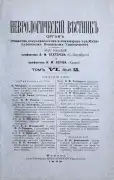Theoretical and practical considerations regarding the study of cranial circulation by measuring blood pressure at the two ends of the carotid artery
- Authors: Telyatnik F.N.1
-
Affiliations:
- Anatomical and physiological laboratory of prof. V.M.Bekhterev
- Issue: Vol VI, No 2 (1898)
- Pages: 95-119
- Section: Original article
- URL: https://journals.rcsi.science/1027-4898/article/view/48645
- DOI: https://doi.org/10.17816/nb48645
- ID: 48645
Cite item
Full Text
Abstract
Of all the methods of studying cranial blood circulation, which I will not list here, the best is the one in which the state of cranial blood circulation is judged by the blood pressure in the two ends of the carotid artery. Hürthle was the first to observe this method, and therefore the method itself is often called the Hürthle method. However, as Hürthle himself says, the idea of a method existed before. So, A. Dastre and J. Morat, for the purpose of proving the existence of vasomotor fibers for the lower limb in n. ischiadicus, determined the blood pressure in the central end of one a. cruralis and in the peripheral end the other; on the side last n. ischiadicus overcame. With irritation of a peripheral nerve cut, the pressure increased in the peripheral end of the а. cruralis, remaining unchanged in the central cut. “This increase in pressure in the operated limb, which coincides with the unchanged pressure in the rest of the body, proves that (with the indicated irritation) there is a reduction in small arteries”.
Keywords
Full Text
##article.viewOnOriginalSite##About the authors
F. N. Telyatnik
Anatomical and physiological laboratory of prof. V.M.Bekhterev
Author for correspondence.
Email: info@eco-vector.com
Doctor
Russian FederationReferences
Supplementary files









